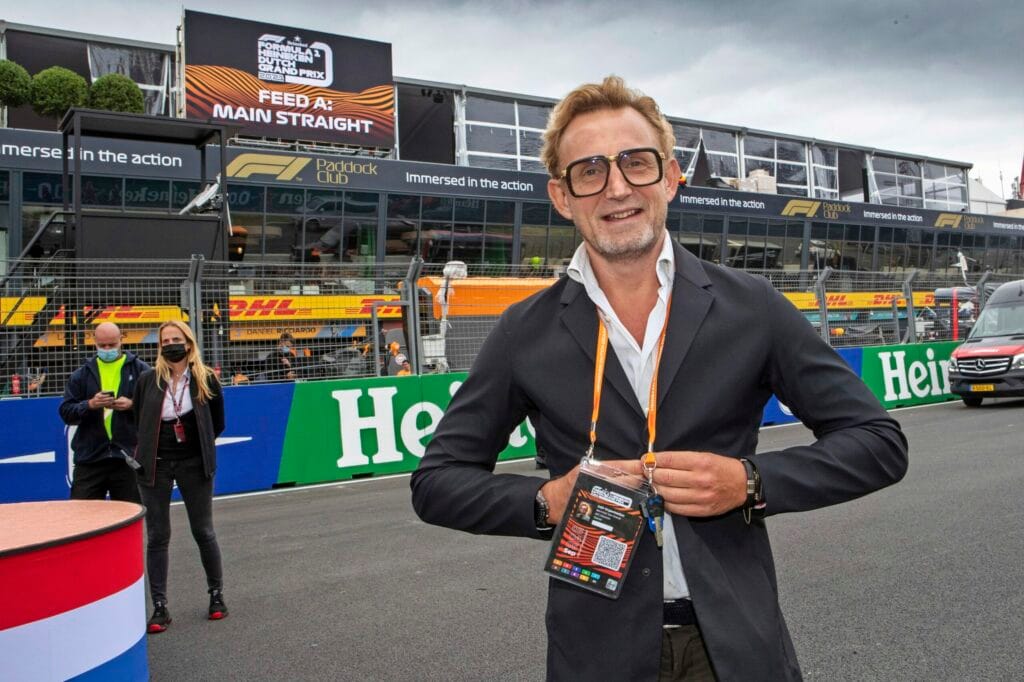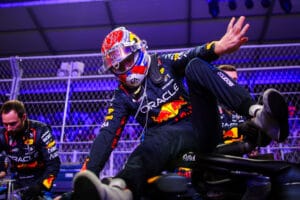The success of the Dutch GP fills circuit owner Bernhard van Oranje with a sense of pride. Two years ago, an exclusive interview with him was published. As we approach the race at Zandvoort and with the knowledge of a story from 2022, he says, “You can’t get away with that at Liberty.”
Thank you for your time, Bernhard. Can you recall your first active memory of Zandvoort?
“I can’t pinpoint my very first moment at Zandvoort. But the first moment that truly stands out was a race course we did there under the guidance of Huub (Vermeulen).”
What was your opinion of Circuit Zandvoort before the makeover?
“Fundamentally, the character of Zandvoort has remained unchanged. It’s technically a very challenging circuit. I think it has become more exciting in some aspects: the Hugenholtz is more fun, although I believe the Arie Luyendyk bend was more thrilling than it is now. But it remains a super technical and tricky circuit due to the elevation changes. It’s never straightforward to drive fast there. Look at Silverstone, it’s somewhat returned at Spa-Francorchamps, but generally, at all Grand Prix circuits, the run-off areas are so large that making a mistake doesn’t really matter. I mean, you just go full throttle. If you happen to go off the track, it’s not penalized. That’s never been possible at Zandvoort. And that, along with the downdrafts you get there, makes it a challenging track to be fast on. I personally find it, and always have, a fantastic circuit to drive.”
Have you ever ended up off the track as a racer?
“I don’t think you can have a motorsport career without making mistakes. So yes, I’ve definitely had some hard crashes. Of course, you get a shock after a hard hit, but it’s part of the job. You know, you can fall in any sport. Then you have to get up and do it again.”
Did you have any input on the circuit modifications with designer Jarno Zaffelli and suggest any changes?
“The condition I set at the beginning was that the characteristic of the track had to be preserved. I also didn’t want huge run-off areas, we pushed hard for that. Fortunately, you can see that coming back now, those run-offs are disappearing. With the European GT4, we drove almost exclusively on Formula 1 tracks and everywhere you went, even at Spa, you saw it happening: all those run-offs were asphalted. And then racing is just much less fun. It sometimes feels like cheating, you can gain almost a second. Are you then caught or not? If that becomes the game, it’s no longer fun. We once drove in Hungary and the free practice was stopped because of the 28 cars, 22 had exceeded track limits in the first lap. That’s not only the case on the Tilke tracks, but on almost every track where Formula 1 came. You could drive almost as hard off the track as on the track. I think that’s really killing for the sport. I’ve made a strong case for it at Zandvoort, saying that’s exactly what you don’t want. And I think that’s what makes the track so cool.”
Was this directed by rights holder FOM or motorsport organization FIA?
“Before we came on the calendar, the policy was really that you had almost wide run-off zones on every corner, you hardly saw a gravel trap anywhere. And in that sense, we were the first to bring that back. There are a lot of people from England in Formula 1, and they agreed with that. Ultimately, the FIA decides on that. But yes, they did agree.”
Do you think Formula 1 has gone in the wrong direction, that they’ve gone too far?
“I think you’ve been able to see in recent races how important it is that they’ve taken a lot of steps in terms of safety. A gravel trap doesn’t necessarily have to be less safe. Look, safety is the most important thing. Let’s put that first. But those run-offs are not necessarily needed for safety in my opinion.”
Bankings are a thing of the past, you hardly see them on modern circuits. Was everyone immediately enthusiastic about the idea?
“Yes, but of course it’s also a concern. You have to see what it does to the tires. But the Hugenholtz has definitely become so much cooler because of it. I really love driving through it myself.”
You’ve probably done that a lot, right?
Laughs: “Now I have, yes.”
When did the idea come to you to buy Circuit Zandvoort? It was almost bankrupt once, wasn’t it?
“At the time we were looking at it, it was certainly not almost bankrupt. Under Hans Ernst (former circuit owner), things were going pretty well. At the end of 2012 or 2013, when the circuit was for sale, we started looking at it.”
Why did you start looking at it? Was it for nostalgic or purely business reasons?
“Just like my business partner Menno de Jong, I thought it would be nice to have a company that was closer to our passion. One that still generates revenue, but where I also saw real opportunities for improvement. That was the reason to buy the circuit in 2016.”
Did you already have the idea to possibly bring back the Grand Prix at that time?
“No, in 2012, 2013 that was certainly not the thought process. The only thing people kept telling me was that I should never start with Formula 1.”
Would the Circuit Have Been Revamped if Formula 1 Hadn’t Been There?
“The track layout hasn’t really changed, right? But those turns (Hugenholtz and Arie Luyendyk) and all those safety matters like tecpro-barriers wouldn’t have been implemented if we hadn’t secured Formula 1. The track’s occupancy rate is good, there’s really no reason to invest in it in that sense. We had already invested significantly in the track when we bought the circuit. We redid the entire asphalt and tackled quite a few issues. So, the modifications that happened afterwards were strictly necessary for Formula 1 and not for our other activities.”
When Max Verstappen Entered Formula 1 in 2015, Did You Immediately Think: We Need to Do Something with This?
“That had already been initiated by Hans Ernst, just before we started. He had already established a certain collaboration with Max Verstappen during the Italian days.”
You Saw the Impact It Had.
“Yes, truly bizarre. I believe 60,000 fans came to watch someone do a demo lap in the Toro Rosso. Fundamentally, the sentiment was very much, also from Red Bull’s perspective: ‘if you have this, why on earth would you want to have Formula 1 there?’ There was really no one who told us: ‘It’s a really good idea to do Formula 1.'”
But You Thought So.
“Well, look, the challenge certainly became greater to take a look at it. To do something that in that sense no one had ever done before.”
How Do You Find the Collaboration and Working Method of Liberty Media? Is It a Pleasant Business Party to Negotiate With?
“I find Stefano (Domenicali, CEO of rights holder Liberty) truly amazing. Especially now that he’s there, we’re completely aligned in how we view the sport and what we consider important for the fans. So, I’m certainly very happy with Stefano and I think the collaboration between our team and Formula 1 is very good.”
How do you perceive modern Formula 1?
“In the past, we’ve had varying discussions, including with former FIA president Jean Todt. They would say, ‘of course, the fans are very important.’ But they would also ask, ‘why do more when you’re already sold out?’ I think now, there’s a much greater focus on fan engagement. How do you ensure people have a good time and get value for their money? This is now a question being asked more of Formula 1 promoters, and it’s just as important to Liberty. For example, at Paul Ricard, almost forty percent of ticket holders didn’t even make it to the circuit. Stefano wouldn’t let that slide; he looks at the sport as a whole. And you can see the result: Formula 1 is now more popular than ever.”
The Dutch GP set a trend last year with a festival-like event.
“Yes, the first race went incredibly well. After that, we were somewhat set as the benchmark for other circuits.”
Is there a chance that Formula 1 might lean too much towards the show element?
“I think, given everything we’re seeing now, the recent developments in the sport have been nothing but positive. Look at the race in Silverstone, they’re doing a lot for the fans there. I believe that at its core, Formula 1 is doing really good things. As for what happens behind the scenes, the negotiations over circuits and fees, and what the agreements are, I can’t really comment on that.”
Is there room for a second Grand Prix in the Netherlands?
“We have the exclusive rights to Formula 1, that’s contractually established. If we were to stop, everything would be available to everyone again. But right now, we’re mainly focused on the upcoming Grand Prix.”
Do you feel pride or emotion when you see what you’ve achieved with the Dutch GP, or do you view it purely from a business perspective?
“From a business perspective, you wouldn’t even consider organizing a Formula 1 race.”
Because it’s not profitable?
“I think we do it in a way that can certainly be profitable. But if you look at the effort you put in and the risks you take, it’s not a business decision. You’d be better off investing your time elsewhere. But I think it’s one of the coolest things we’ve done as a team. Because we get to organize, I believe, the biggest sporting event that the Netherlands can attract.”
Seemingly Impossible Becomes Reality
“Yes, but the momentum with Max is extraordinary. We have never had such talent in the Netherlands. Regardless of whether he is now a world champion, or was then able to compete for the championship, a Formula 1 Grand Prix is the biggest event you can get in the Netherlands as a sport. I also think it’s very good for the Netherlands, and I think it’s cool that we were able to do this.”
A Touch of Pride
“Well, yes, to some extent I am proud, but I am mainly proud of the entire team that has done all this. I find it very beautiful in that sense that we succeeded.”
Can You Enjoy the Excitement of the Weekend?
“Certainly not that weekend, I found it very stressful. The tension of such an event, you know everyone is watching. Afterwards, everyone and everything is positive. But of course, not before. There was a lot of tension for me. On the other hand, it feels unreal when you see those Formula 1 trucks all standing on the track for the first time. That’s a pleasure, because you’re also just a fan.”
Do You Feel Appreciated?
“You notice that everyone thought it was super, incredibly cool. Also because of the energy that was there. The people I spoke to myself, thought it was top-notch. But that’s not the reason why you do it.”
We Ask Because, Let’s Be Honest, Not Everyone in the Netherlands is a Big Fan of You or Racing
“People who are not fans you often hear, and the people who are very fanatical or positive, you hear less. But I do think that everyone who was there, the people I spoke to, enjoyed it. And they appreciate it very much. And when I meet Formula 1 fans, I only hear how happy they are that we also have a race in the Netherlands. So in that sense, among Formula 1 fans, I never hear negative sounds. I don’t do it for the appreciation, I’m a fan myself. I think it’s very cool that we have a Grand Prix in the Netherlands and I think it’s cool that we have Max. Of course, it also gives energy when you see that the people who were there enjoyed it so much. You saw it in the viewing figures for Formula 1, which had never been so high. You saw that in the Netherlands the overall appreciation that we had a race, was high. And afterwards, you only saw positive newspaper articles. So that’s nice.”


